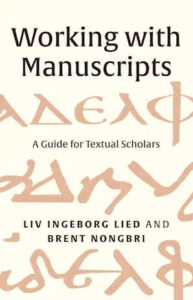LIED, L. I.; NONGBRI, B. Working with Manuscripts: A Guide for Textual Scholars. New Haven, CT: Yale University Press, 2025, 192 p. – ISBN 9780300264425.
Embora manuscritos sejam raros na maior parte do mundo hoje, eles já foram onipresentes. Antes da imprensa, a literatura era preservada e transmitida por meio de cópias manuscritas contendo leituras variantes, erros, correções e outras características únicas. Aqueles que estudam textos pré-modernos, no entanto, frequentemente usam como fontes primárias não esses artefatos diversos, mas edições críticas que apresentam um único texto híbrido conveniente.
cópias manuscritas contendo leituras variantes, erros, correções e outras características únicas. Aqueles que estudam textos pré-modernos, no entanto, frequentemente usam como fontes primárias não esses artefatos diversos, mas edições críticas que apresentam um único texto híbrido conveniente.
Brent Nongbri e Liv Ingeborg Lied argumentam que o conhecimento de manuscritos é importante para todos os intérpretes de textos antigos, mesmo que aprender a estudá-los possa ser confuso e intimidador. Neste livro, eles se baseiam em suas décadas de experiência com manuscritos judaicos e cristãos para desmistificar o trabalho com manuscritos. Combinando seus interesses em manuscritos como artefatos materiais com as questões éticas que cercam o estudo de manuscritos, Lied e Nongbri guiam os alunos pelas principais fases da pesquisa, desde considerações sobre procedência e acesso até os aspectos práticos da pesquisa, análise e publicação in loco. O livro inclui recursos para localizar manuscritos, estudos de caso úteis, dicas para organizar dados, um glossário, sugestões de leitura complementar e muito mais.
 Escrito em um estilo envolvente, com foco nos estudantes, este manual oferece um recurso inestimável para quem deseja estudar um manuscrito pela primeira vez.
Escrito em um estilo envolvente, com foco nos estudantes, este manual oferece um recurso inestimável para quem deseja estudar um manuscrito pela primeira vez.
Liv Ingeborg Lied é professora de estudos religiosos na MF Escola Norueguesa de Teologia, Religião e Sociedade, Oslo, Noruega.
Brent Nongbri é professor de história das religiões na MF Escola Norueguesa de Teologia, Religião e Sociedade, Oslo, Noruega.
While manuscripts are rare in most of the world today, they were once ubiquitous. Before the printing press, literature was preserved and transmitted through handwritten copies containing variant readings, mistakes, corrections, and other unique features. Those who study premodern texts, however, often use as their primary sources not these diverse artifacts but critical editions that present a single convenient hybrid text.
Brent Nongbri and Liv Ingeborg Lied argue that knowledge of manuscripts is important for all interpreters of ancient texts, even if learning how to study them can be confusing and intimidating. In this book they draw on their decades of experience with Jewish and Christian manuscripts to demystify manuscript work. Combining their interests in manuscripts as material artifacts with the ethical issues surrounding the study of manuscripts, Lied and Nongbri guide students through the main phases of research, from considerations of provenance and access to the practicalities of on-site research, analysis, and publication. The book includes aids for locating manuscripts, helpful case studies, tips for organizing data, a glossary, suggestions for further reading, and more.
Written in an engaging style with students in mind, this handbook provides an invaluable resource for anyone who wants to study a manuscript for the first time.
Liv Ingeborg Lied is professor of the study of religion at MF Norwegian School of Theology, Religion, and Society. She is the author of Invisible Manuscripts: Textual Scholarship and the Survival of 2 Baruch.
Brent Nongbri is professor of history of religions at the MF Norwegian School of Theology, Religion, and Society. He is the author of God’s Library: The Archaeology of the Earliest Christian Manuscripts.
